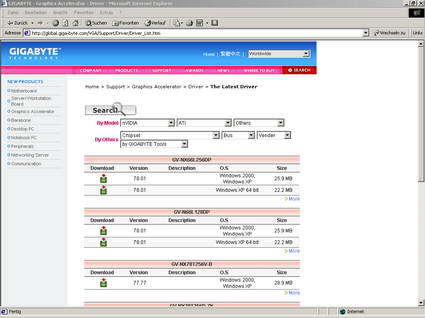Seven of NVIDIA's Latest and Greatest Cards Tested
Web Support
The support and download website is easily accessible and very responsive. Unfortunately, the driver version offered there was outdated. In this case, the best course of action is to install the newest version of NVIDIA's reference driver and then add Gigabyte's VTuner 2.
Overclocking And Heat
Gigabyte's monitoring and overclocking tool VTuner 2 enables users to change the memory and GPU frequencies. By default, the VTuner 2 sets the card to run at 500/1000 MHz (GPU/memory). However, it is not clear what speeds are recommended or even possible. Ambitious overclockers are best advised to begin with the Coolbits registry hack to determine the optimal clock speeds. This hack unlocks the frequency selection dialog in the NVIDIA reference drivers, but as usual, beware that the manufacturer will not cover any damage to the hardware as a result of overclocking-related overheating. In our test, the driver's automatic detection routine suggested a maximum clock speed of 541/1082 MHz for our card.
At default speeds, the GPU's temperature ranges from 62 to 89 degrees Celsius (2D/3D). When overclocked, the temperature rises a few degrees to 66 and 92 degrees, although the card is likely to run a little hotter under extended load. Therefore, a case with good airflow - one using additional fans, for example - is strongly recommended, and practically a prerequisite for this card.
Get Tom's Hardware's best news and in-depth reviews, straight to your inbox.
Current page: Web Support
Prev Page Tools And Software Next Page SLI 2x Gigabyte 6600 GT Silentpipe II
